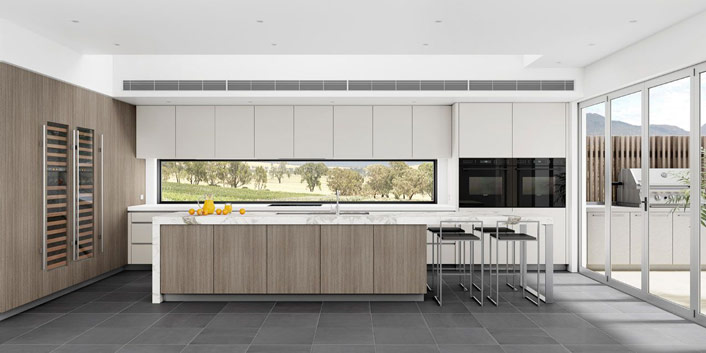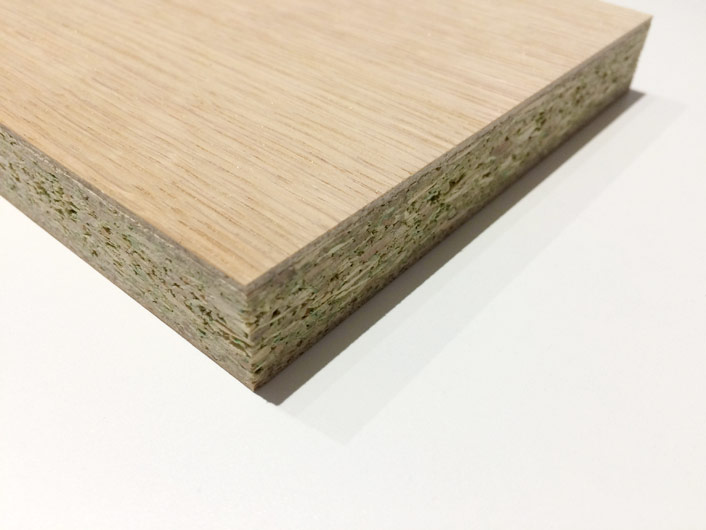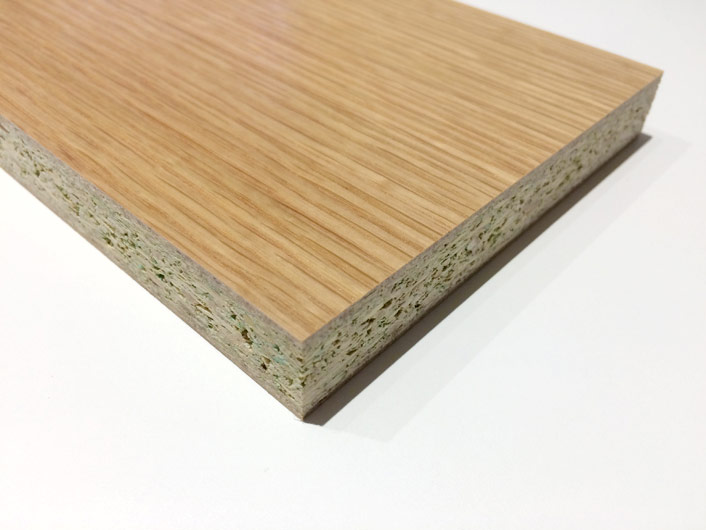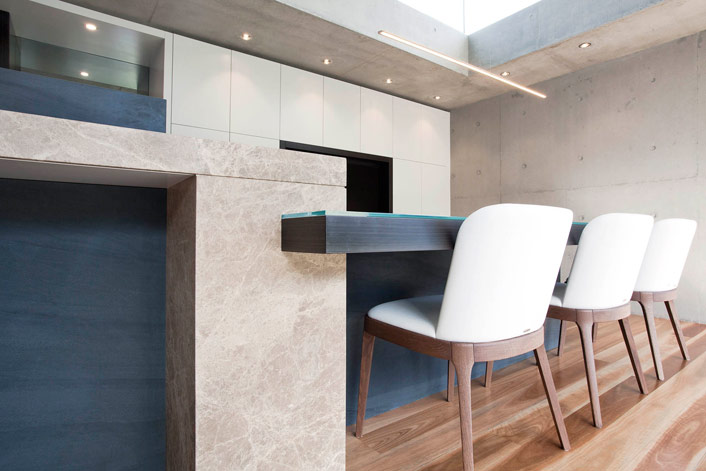
Veneer board used to great effect in this kitchen design.
Timber veneer is a surfacing material that is both decorative and individual, as no two veneers are alike. You can choose from a huge variety of species, colours and timber grains in order to add warmth, ambience, style and a touch of nature to your bespoke kitchen.
What is veneer?
Timber veneer comprises of thin slices of timber (as little as 1mm) glued onto a substrate of plywood, craft-wood or particle board. There are two main types – natural wood veneer and engineered wood veneer. The intrinsic patterns in natural veneer remain unaltered (apart from an applied stain), while engineered veneer is made from a reconstructed timber, often Poplar or other plantation timber, dyed or stained to get a particular appearance.
Just a couple of the ways veneer is sliced from a timber log. Each method produces a different grain pattern.
How a timber log is cut determines the grain pattern in veneer. Popular cuts include; crown cut, which have bold curves and ovals within the grain; quarter cut, which is characterised by a pattern of straight lines in the grain; and rotary cut, which is predominately used in plywood and creates a multi-coloured, swirled grain.
Veneer vs solid timber

This kitchen utilises Australian Jarrah in the form of veneer (see the tall cabinets on the left) and solid timber (see the lattice doors on the island). The veneer and solid timber work in harmony to bring this kitchen together. Without being informed you’d easily believe you were looking at solid timber kitchen.
Timber veneer panels offer a few advantages over solid wood, in that it’s more economical, environmentally friendly, and is much less prone to warping or cracking. The main disadvantage is veneer cannot be shaped or routed into without revealing the underlying substrate.

Timber edge banding on a jarrah veneer door.
You can tell the difference between veneer and solid wood via the presence of edge banding – a thin piece of solid timber used to cover up an unfinished edge of veneer board. Furthermore, if the grain doesn’t follow the same direction across all surfaces, it’s veneer.
The benefits of using veneer in your kitchen
Colour choice: Veneer adds colour, texture and tone to an otherwise muted space. Veneer can also be stained, dyed or painted for further tailoring of the aesthetic.
Softness: Veneer can make a hard edged kitchen look softer.
Natural: Veneer combines well with other natural materials (such as marble or stone) in and around the kitchen space.
Design flexibility and shape stability: It’s cheaper than most solid timbers (when compared to the same species in solid material), available in larger sheet sizes for greater design flexibility, and has better resistance to cracking and warping.
The drawbacks of veneer
Difficult to repair: Scratches through the clear coat and into the veneer can be difficult to repair. Deep gouges will go through the veneer layer revealing the substrate underneath which again can be difficult to repair.
Discolours at high temperature: Avoid if possible using veneer in high temperature areas, such as behind cooktops, as the timber and clear coat can discolour with long exposure.
Dislikes water: Using veneer in areas of steam should also be avoided if possible. The clear coat protects the veneer from moisture, but if this coating is warn from excessive cleaning/polishing, the veneer may be prone to expansion with long exposure.
Can discolour with UV light exposure: All veneers, and in particular veneers that are treated with a stain or dye, are prone to varying degrees of colour change when exposed in areas of high UV light. Manufacturers can and should use UV inhibitors in their clear coating to help combat this.
Veneer must be the same on both sides: If the back surface of any veneer panel (take for instance the back of doors and drawer fronts) does not have the same veneer as the front applied, the panel can bend. Applying the same veneer to the back will balance the stresses within the panel, keeping it in shape. Ensure your kitchen manufacturer or joiner follows this principle.
The clear coat

Image 1: Uncoated American Oak quarter cut veneer (un-edged showing the substrate).

Image 2: Polyurethane coated American Oak quarter cut veneer (un-edged showing the substrate). Notice how the colour deepens, the surface becomes more reflective and the grain is filled in after lacquering.
Touching further on the subject of the clear coating, you couldn’t have timber veneer in the kitchen without it. It is a polyurethane based coating system that essentially provides a protective barrier for the wood and substrate. Many kitchen companies apply different clear coats. Some add a high gloss finish (much like a piano top) that make the veneer look very shiny. Others, apply a very thick matt finish. This method can make the veneer look like plastic as it fills in the grain texture, appears foggy and can easily show up areas of over polishing/cleaning. The preferred method for most kitchen companies and joiners is to take a more natural approach, applying an even coating at about 30% gloss level. This is easy to clean, shows the grain texture and looks the most natural.
Care and maintenance of timber veneer

In this kitchen, the light natural stone contrasts with the dark veneer for a striking look. Additionally, to further protect the veneer a glass sheet is placed on top.
Timber veneer is not the easiest material to maintain but with this advice you will be as prepared as you can be:
- Wipe away spills immediately, and if you have a timber bench, use placemats or coasters to avoid staining.
- Avoid using harsh chemicals or abrasive cleaners to clean the surface. Doing so will strip the clear coating over time.
- Combat oil build-up on surfaces by wiping them with a soft micro-fibre cloth.
- If you’re planning to surface a breakfast bar with veneer, consider using a glass top for added protection.
- Avoid dragging or knocking heavy objects against the surface.
- If in doubt, contact your kitchen company for advice.
Looking to use veneer in your kitchen? See it first before committing.
Timber veneer is a product that can be more expensive then a polyurethane door. Even on this basis, if you are considering using it, it warrants further investigation. All kitchen manufacturers have different ways of working with veneer and applying it to their kitchen designs. With the knowledge provided here, we encourage anyone who is considering a veneer kitchen to inspect firsthand. As a manufacturer of Scandinavian style kitchens, we at Dan Kitchens have a long history of working with timber veneer and have many examples in our luxury kitchen showroom for you to see. We are also more than happy to take you into our factory to show you how our joiners work with this amazing material.

